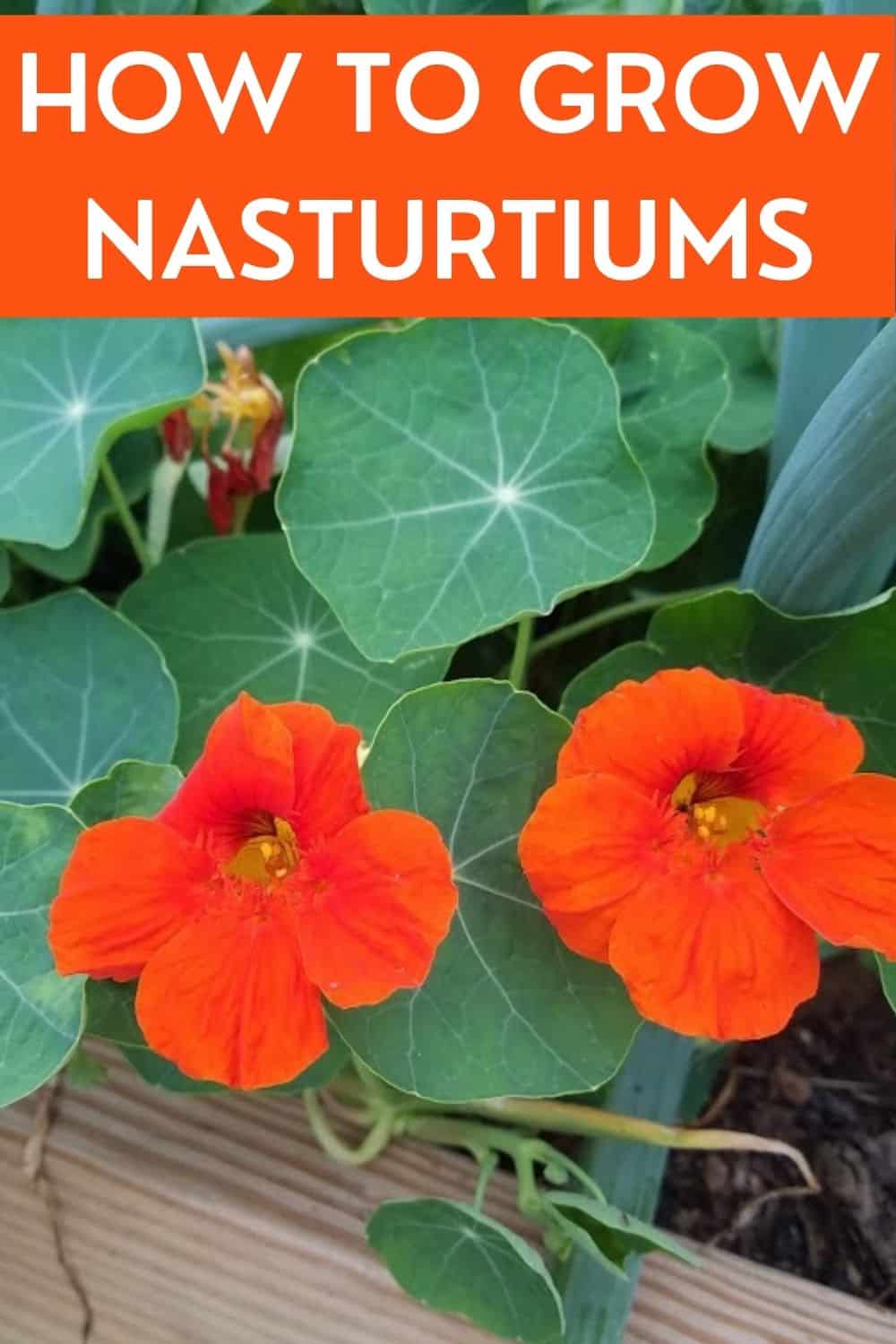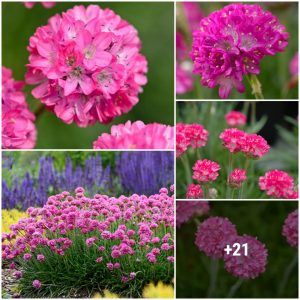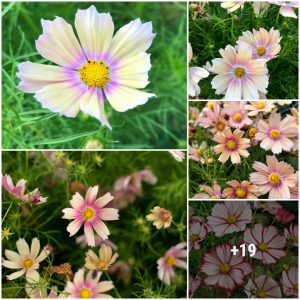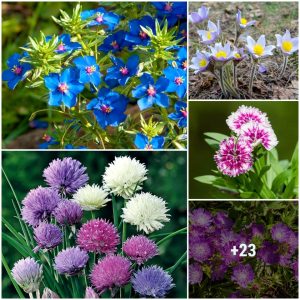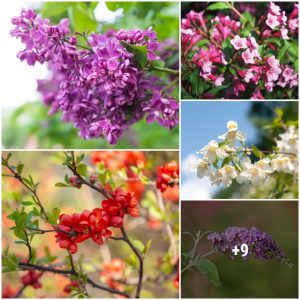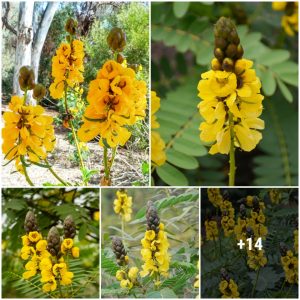Nasturtiums are beautiful plants with a lot of benefits! Not only are they edible, but they are great for companion planting as a trap crop and are great sources of pollen for pollinators to visit. As with any plant, it can be confusing knowing their specific needs and care. So, here is how to grow nasturtiums.
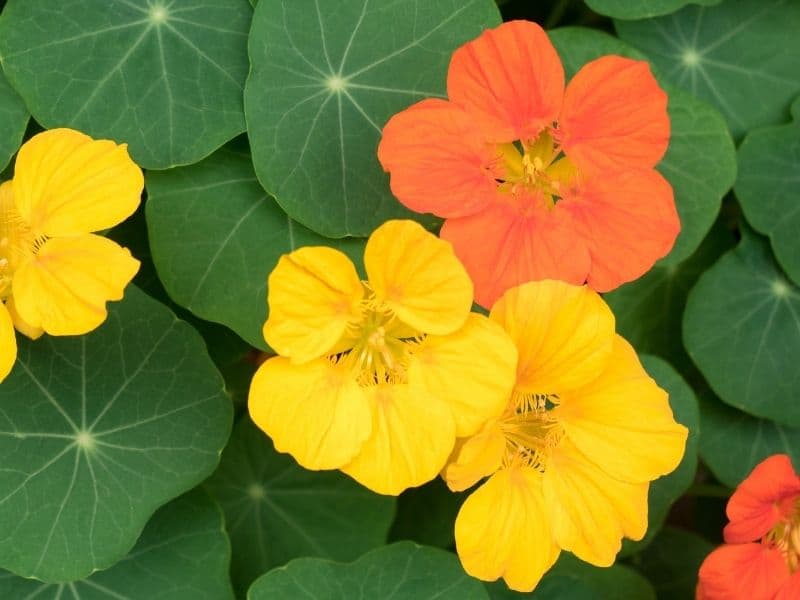
Nasturtium varieties
Nasturtiums are divided into two main categories: bush and trailing or climbing types. The main difference lies in growth habits. Bush varieties remain more compact and are great for small gardens with limited space. Trailing types, create long vines and are great options for window boxes or hanging baskets, but can be placed in gardens if provided the right support.
Some examples of bush varieties are:
- Alaska Variegated: a mixture of flower colors and variegated foliage
- Peach Melba: the flowers are a pale yellow color with an intense orange-red center (see how they look and buy peach Melba nasturtium seeds from amazon.
- Black Velvet: intense red flowers that are so rich they appear black (buy black velvet nasturtium seeds on amazon)
Some examples of trailing/climbing varieties are:
- Variegatus: beautiful red or orange flowers and trailing vines
- Spitfire: as the name implies, the flowers are a brilliant scarlet color
- Climbing Phoenix: split petals shaped like little flames (see it here)
When to plant nasturtium seeds
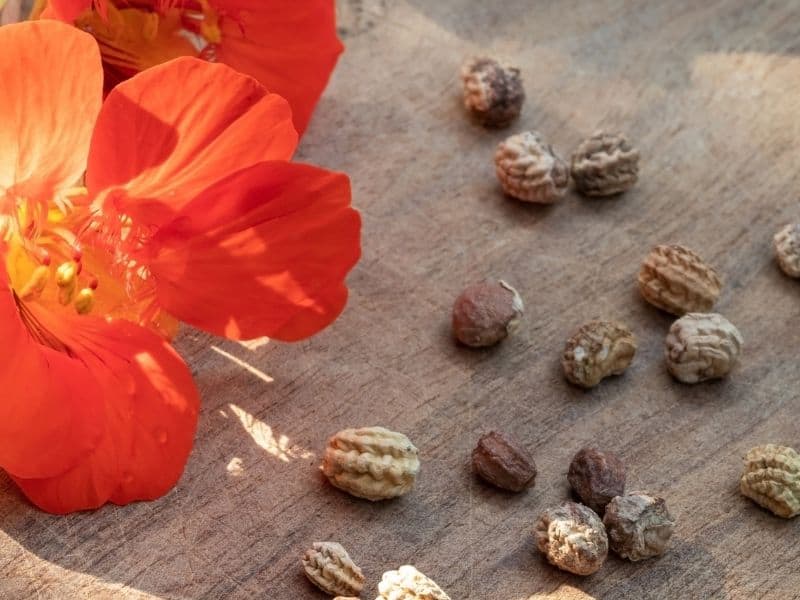
Timing your planting depends entirely on the location of the planting. When started indoors, it is a good idea to start seeds two to four weeks before the last spring frost.
However, nasturtiums are extremely fragile and do not always survive a transplanting process. Many prefer to sow nasturtium seeds directly into the garden, approximately one to two weeks after the last frost (soil temperature should be between 55º-65ºF, or 12º-18ºC).
If you choose the direct option, have a plan to protect the seedlings from a potential late frost.
How to prepare the planting site
Nasturtiums grow well in full sun areas in sandy, slightly acidic to neutral soil. While nasturtiums can grow in partial sun, they do not bloom as well. Things to consider while preparing your planting site:
- The soil should be well-draining
- Plan for a late frost for your nasturtiums and/or supports for trailing nasturtiums
- If you are companion planting, plan for distance to prevent overcrowding
How to plant nasturtiums
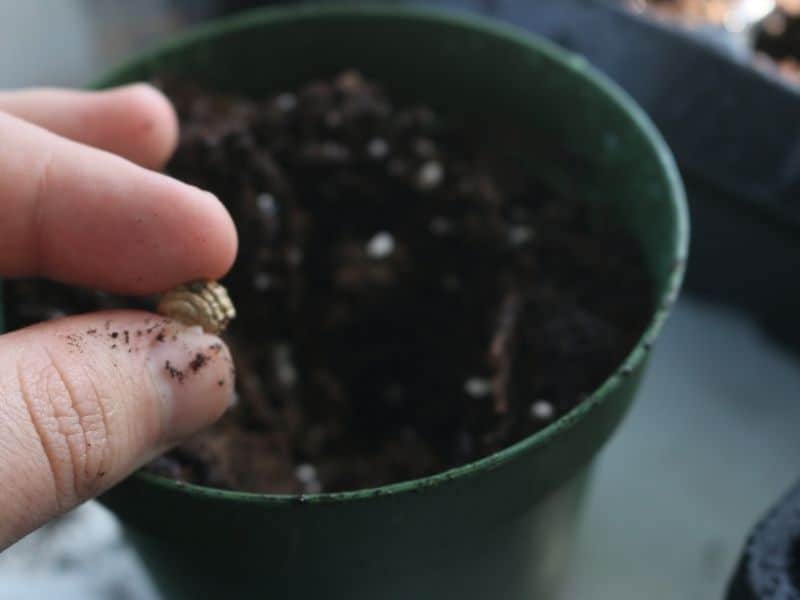
Nasturtium seeds should be sown into the soil at about half an inch deep. Keep approximately ten to twelve inches apart from each plant. Keep in mind spacing if you are companion planting your nasturtiums with other garden vegetables.
How long does it take nasturtium seeds to germinate
The germination period for nasturtiums is relatively quick. You can expect that your nasturtium seeds germinate between 10 to 14 days after planting in optimal conditions. If starting your seedlings indoors, thin your plants to one in each pot by taking out the weaker seedling.
How long does it take nasturtiums to grow
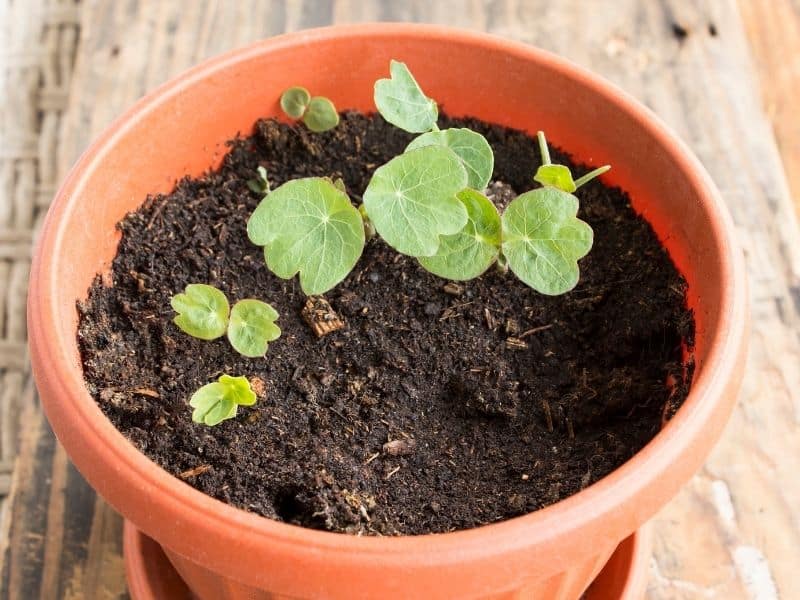
After the germination stage, plants can begin to emerge within 7 to 10 days in optimal conditions. Those in full sun will start growing and sprouting sooner than those in partial shade. If you started your nasturtiums indoors, wait until the plants have a strong enough root structure to be transplanted by waiting until the plant is showing more growth.
How long does it take nasturtium to bloom
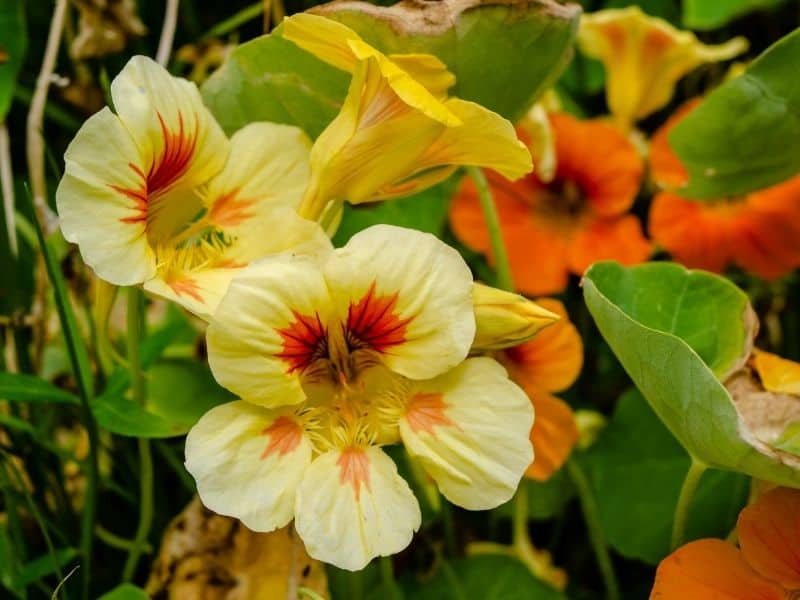
In full sun, correct soil, and with quality watering practices, nasturtiums bloom (or flower) between 35 to 52 days after germination. This depends on the type of nasturtiums, as bush varieties may flower earlier than climbing varieties. Also, if nasturtiums are in partial shade areas, it may take longer to bloom.
How to care for nasturtium plants
As with any plant, it is important to water nasturtiums regularly. Nasturtiums are somewhat drought tolerant but thrive best in moist soil. It is equally important to avoid overwatering as well.
In the summer months, nasturtiums may become heat-stressed and stop blooming. You can also determine if the nasturtiums are heat-stressed if their flavor is particularly intense. Sufficient watering can help mitigate these effects.
Dead-heading and pruning are greatly beneficial to nasturtium plants, as this provides room for new flowers and foliage. If you are growing nasturtiums in a container, you should trim back the plant to encourage new growth.
How to harvest nasturtiums
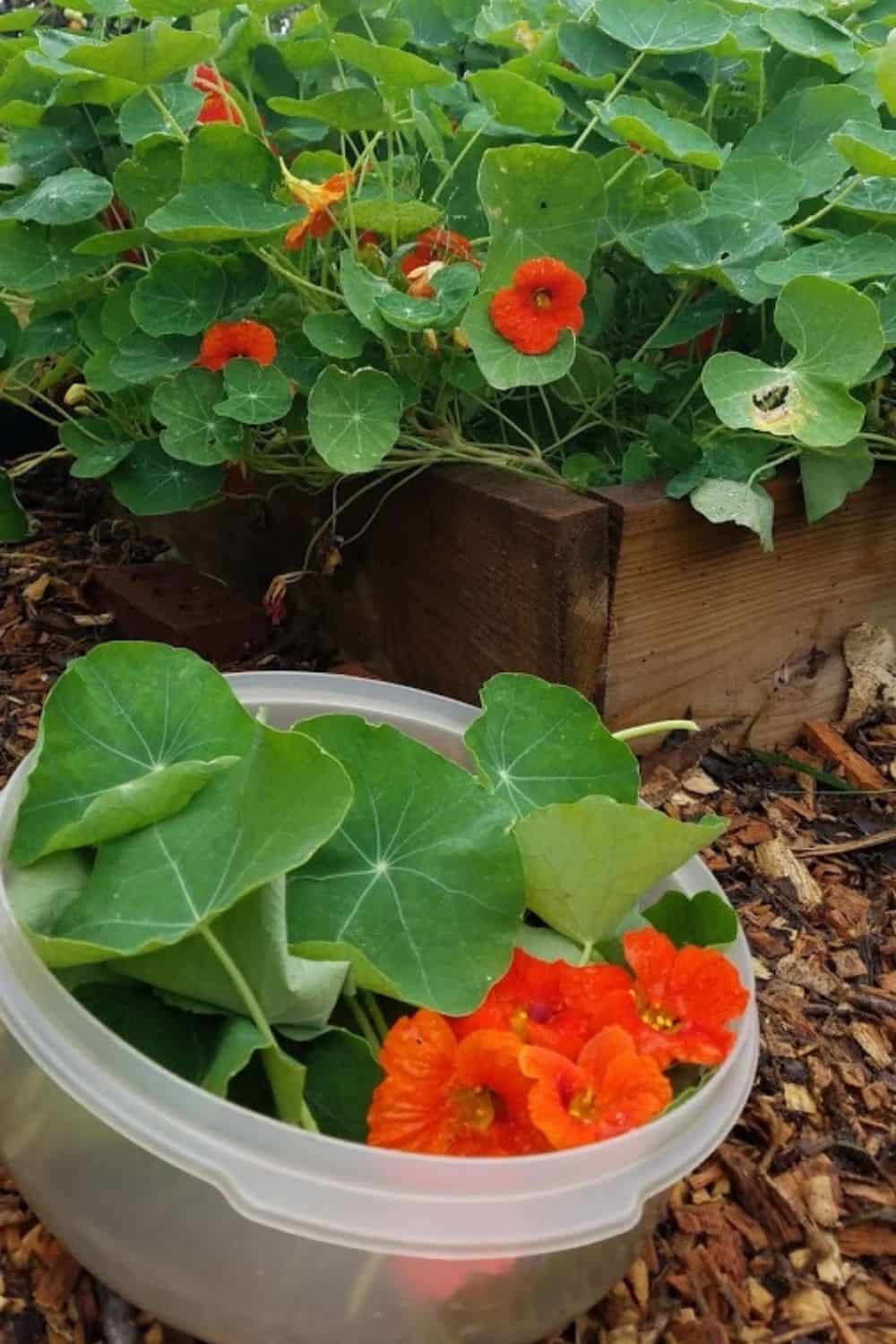
It is important to take care when harvesting nasturtiums: take a quality pair of scissors and snip off leaves, flowers, and seedpods. This is the best practice to avoid damaging the plant.
Make sure you harvest often to help the plant produce even more delicious goodness!
When to harvest nasturtiums
It depends on the reason you are harvesting. If you want to make stuffed nasturtium leaves, you’ll need to wait for the leaves to grow big enough. For salads, you want smaller, more tender leaves; and of course, if you want flowers in your salad, you’ll need to wait for the plant to bloom.
If you want to use the seeds for cooking, make sure to harvest them before they harden.
If you want to save your own seeds for the next season, allow a few of the seed pods to mature and harden. Keep them in a paper envelope in a cool, dark place for storage until the next season.
Why you should grow nasturtiums
Nasturtiums are edible! The peppery, mustard-like taste is a great addition to any salad or to garnish soups or sauces, especially pesto sauce.
But Nasturtiums are also beneficial to your garden! Companion planting (growing complementary plants together) with nasturtiums allows for more valuable vegetables to prosper, as these flowers attract a host of insects and pests.
But they are not just trap crops for the bad pests: the nasturtium flowers attract helpful pollinators like bees and hummingbirds.
FAQ
Do nasturtium plants need to climb?
Not all nasturtiums need to climb, but those that are trailing or climbing types do. It is key to provide the right supports for your plants that are climbing varieties to help them along.
Do nasturtiums come back every year?
Nasturtiums are annual plants, meaning they only survive for one growing season. However, they can adapt to become perennial plants (those that come back after the winter) in frost-free zones.
Do nasturtiums grow well in pots?
Yes! Nasturtiums can be grown in pots. It is important to take into consideration the type of nasturtiums that are being planted. Bush varieties are great in all pots. Climbing or trailing varieties, however, need a space between the planter and the ground, making window boxes or hanging baskets the optimal choice. This allows for the vines to grow and drape without being stepped on or otherwise disturbed.
Are nasturtiums hard to grow?
Not at all! If you are worried about the strength of your green thumb, nasturtiums are one plant that can increase that muscle. If you follow the care instructions and keep this plant in its optimal conditions (sandy and neutral soil that is kept moist and in full sun), they will grow easily!
What kind of soil does nasturtium need?
Nasturtiums need sandy, slightly acidic to neutral soil that is well-draining. They do well in poorer soils as well, but it is important to note that the chemical balance of the soil can impact the growth of nasturtium flowers. Too much nitrogen can produce more foliage rather than flowers.
Are nasturtium plants good for the soil?
Yes! At the end of the growing season, you can leave the plants to decompose naturally. The nutrients from the plant enrich the soil over decomposition, making for great, nutrient-rich soil the next season. During the growing season, when pruning and deadheading your nasturtiums, you can leave the remnants on the ground. This makes for a natural mulch for your other plants.
Hopefully, you are confident now that you know how to grow nasturtiums, and experiment with adding them to your cooking too. We were pleasantly surprised last year when we first planted it and used it in our food.
